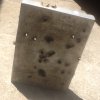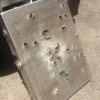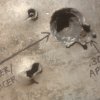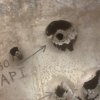I found this piece of armoured plate believed to be from a Ram tank used as target practice on a Piat range. As you can see two holes punched at the top and spall marks from the hollow charge round and the cracks in the armoured plate. Anyone else have holed plating or armour penetrated by projectile, hollow charge, HESH or AP round. REME welding workshop years ago had a interesting collection of defeated armour. Interesting to see the effects such rounds had on armour. Anyone got any interesting pieces to show of defeated armour
British Ordnance Collectors Network
You are using an out of date browser. It may not display this or other websites correctly.
You should upgrade or use an alternative browser.
You should upgrade or use an alternative browser.
Defeated armour plate from projectiles
- Thread starter BMG50
- Start date
Przezdzieblo
Well-Known Member
Early shaped charge warheads did not function properly quite often. Donald R. Kennedy ("History of the shape charge effect") recalls:
In 1951, this writer was invited to observe infantrytraining at Camp Roberts, California, where it was obvious that the 2.36-inch Bazookaswere, for the most part, failing to detonate high order and form a jet as designed. Instead,most of the rounds were apparently functioned low order from crush-up on the target, asevidenced by the presence of many undeformed conical liners laying about on the test field.Further, the damage to the armor targets usually resembled that produced by a HEP or squashhead mechanism. Even the Army instructors seemed to be unaware that their Bazookaswere malfunctioning. They described the Bazooka's terminal effect as "discharging abaseball sized chunk of metal from the far side of the armor." There was no mention of apenetration hole.
Note that Bazooka projectile was more advanced than PIAT, f.e. it got cone with more acute angle and stronger explosives. There were also some major quality issues with PIAT bombs production, f.e. cone was not attached strongly enough and it moved inside head during transport, there were voids in explosive filler etc. Hence many remains of early HEAT hits could look just like pieces from the first post of this topic.
In 1951, this writer was invited to observe infantrytraining at Camp Roberts, California, where it was obvious that the 2.36-inch Bazookaswere, for the most part, failing to detonate high order and form a jet as designed. Instead,most of the rounds were apparently functioned low order from crush-up on the target, asevidenced by the presence of many undeformed conical liners laying about on the test field.Further, the damage to the armor targets usually resembled that produced by a HEP or squashhead mechanism. Even the Army instructors seemed to be unaware that their Bazookaswere malfunctioning. They described the Bazooka's terminal effect as "discharging abaseball sized chunk of metal from the far side of the armor." There was no mention of apenetration hole.
Note that Bazooka projectile was more advanced than PIAT, f.e. it got cone with more acute angle and stronger explosives. There were also some major quality issues with PIAT bombs production, f.e. cone was not attached strongly enough and it moved inside head during transport, there were voids in explosive filler etc. Hence many remains of early HEAT hits could look just like pieces from the first post of this topic.
Last edited:
Alittle off topic, but here is a 2.5" plate of 7075-T6 aluminum ( used in some aluminum armored carriers). A few Fourth of July s ago when I owned a .50, I shot .50 API, ball, and spotter tracer rounds from about 100 yds..The .50 API went through like butter, the ball did not go all the way but bulged the rear, and the most interesting was the spotter tracer, it blew/ melted a huge 2.5" wide crater about and inch plus deep.The 308 AP and API penetrated the length of the core, the bases could be seen flush with the surface....Happy Fourth to all....my youngest and I have a long day planned, a parade and three grocery bags of fun.
Attachments
Last edited:
Given how the Bazooka failed to stop T-34-85s with less armor than the M6A5 was rated for, I'd call that old/poorly stored ammo and a failure to actually explain the mechanics of armor penetration to the instuctorsEarly shaped charge warheads did not function properly quite often. Donald R. Kennedy ("History of the shape charge effect") recalls:
In 1951, this writer was invited to observe infantrytraining at Camp Roberts, California, where it was obvious that the 2.36-inch Bazookaswere, for the most part, failing to detonate high order and form a jet as designed. Instead,most of the rounds were apparently functioned low order from crush-up on the target, asevidenced by the presence of many undeformed conical liners laying about on the test field.Further, the damage to the armor targets usually resembled that produced by a HEP or squashhead mechanism. Even the Army instructors seemed to be unaware that their Bazookaswere malfunctioning. They described the Bazooka's terminal effect as "discharging abaseball sized chunk of metal from the far side of the armor." There was no mention of apenetration hole.
Note that Bazooka projectile was more advanced than PIAT, f.e. it got cone with more acute angle and stronger explosives. There were also some major quality issues with PIAT bombs production, f.e. cone was not attached strongly enough and it moved inside head during transport, there were voids in explosive filler etc. Hence many remains of early HEAT hits could look just like pieces from the first post of this topic.













